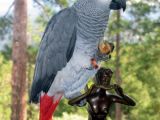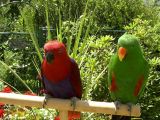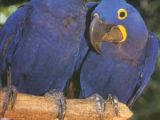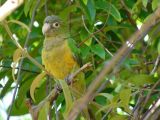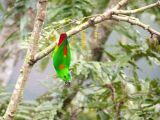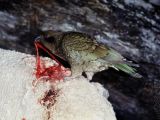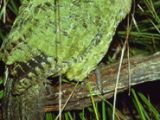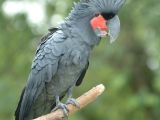Parrots remain the most popular pet birds. This is due to their fascinating colors, their intelligence, attachment to their owners and their ability to imitate the human voice, but also to their adaptability to the captive life. This is exactly what led many species to the brink of extinction, and some species are already extinct. The annual illegal traffic of parrots bypasses 100 million birds. In the case of some species, the poachers destroy up to 70 % of the nests, and the rarer a parrot, the most expensive it turns.
Still, some species are so numerous, that they are considered pests in their countries of origin, attacking in huge flocks the crops, like the Budgerigar (the most common pet parrot around the world) in Australia. Others are anthropic birds, like sparrows in Europe, thriving inside the human settlements, like Galah (Eolophus roseicapillus), Crimson Rosella (Platycercus ellegans) and greater sulfur Crested Cockatoo in Australia.
There are 350 species of parrots, 21 of cockatoos, and 55 of Lorikeets, in the intertropical areas, and only in the Southern Hemisphere they also inhabit temperate areas (in Australia, New Zealand and South America) (if we ignore the extinct Carolina Parakeet, exterminated in North America as it was considered a pest). Most parrots are widely spread in Australia and South America. Paradoxically, the oldest parrot fossil comes from Europe (being 50 million years old), the only continent without any native species of parrots (some feral populations do exist).
Cockatoos are characterized by their large crests, while Lorikeets have specialized tongues, with many protrusions on the tip and a tuft of papillae (extremely fine hairs), extremely effective in collecting nectar and pollen (this type of tongues are found in many nectar eating species, like other birds and bats).
Here are 10 outstanding parrot traits:
1.For centuries people have appreciated parrots' ability to imitate the human voice. The most appreciated species is the African Gray Parrot (Psittacus erithacus), from the rainforests of Africa, considered also one of the most intelligent birds.
Although there is a great deal of debate as to just how well these birds actually understand the meaning of the words they speak, there is little doubt whether they and other parrots (especially macaws and cockatoos), along with corvines (crows, ravens, and jays), are highly intelligent in comparison with other birds.
Still, parrots do not imitate the voice of other birds in the wild, that's why their imitating ability remains an enigma for the researchers. In this case, the best imitator of the voice of other birds is the mockingbird (Mimus polyglottos), an American native.
Talking about intelligence, here is a complex behavior found in the Greater Sulfur Crested Cockatoo (Cacatua galerita) and many other parrots: while the group is foraging on the soil, a few individuals stay on guard on the nearby trees and in case of danger, they signal the danger with powerful, raucous calls.
This type of behavior is usually found in intelligent mammals.
2.The Eclectus Parrot (Eclectus roratus), one from the Solomon Islands, New Guinea, northeastern Australia and the Maluku Islands (Moluccas), has one of the most striking color sexual dimorphism. The males of the species are bright green, having bright candy corn-colored upper mandibles and black lower mandibles, and blue or red tail and wing feathers and the females are red headed and blue to purple breasted, with black beaks. The first European ornithologists to see Eclectus parrots thought they were of two distinct species.
3.The largest parrot in the world is the Hyacinth Macaw (Anodorhynchus hyacinthinus). It is found in the Amazon region, reaching 100 cm (3 ft) in length, being as big as a pheasant. In fact, the group of macaw species, found in tropical America, from southern Mexico to northern Argentina, represents the largest parrots in the world. Macaws have also an extremely long life, over 45 years.
4.The smallest parrots in the world are the pygmy parrots (Micropsitta species) found on the Island of New Guinea and surrounding archipelagos. They can be just 8 cm (3.2 inch) in length, a little bit larger than small hummingbirds.
5.Kakapo or owl parrot (Strigops habroptilus) from the New Zealand is the only nocturnal parrot. It is also the only parrot totally devoid of the flying ability, that's why on the main islands it has been totally eliminated by the predators introduced through European colonization. This is also the heaviest parrot: up to 4 kg (9.6 pounds), three times heavier than a macaw. Macaws are longer due to their Tails that can represent half of the body length.
6.Parrots usually eat plant food, completed by some small insect food for proteins. But there are also some exceptions: predatory parrots. Kea (Nestor notabilis) from New Zealand is the largest carnivorous parrot in the world (the size of a crow). Its diet is varied, and it will usually consume carrion. But since the introduction of sheep in New Zealand, this parrot attacks them on the back, tearing their skin to reach the grease layer below. That's why till it received protection, this bird had been intensively hunted.
The Antipodes Island Parakeet (Cyanoramphus unicolor) is endemic on the Antipodes Islands (south of New Zealand), in a subpolar climate (!). They eat leaves, buds, grass, and tussock stalks, seeds, flowers, and will scavenge dead seabirds, but also preys on Grey-backed Storm-petrels. It will enter burrows to kill incubating adults, even dig at the entrance if it is too small.
7.The hanging parrots (Loriculus species) have the unique habit amongst birds to sleep with the body hanging upside down, like the bats. They live in Southern Asia, from Indonesia to New Guinea and are the only ones, besides bats, known to do this.
8.Unlike other birds, and most vertebrates, the upper jaw of the parrots is mobile. This and their curved beaks confer to the parrot species the ability to develop enormous forces, cracking down extremely hard nuts, that no other animal can feed on, like Macaws, The African Gray or Palm Cockatoo. Parrots and only some fish species posses the unique mobile biting upper jaw. Parrot owners know very well the power of parrot bite.
9.There is at least one species of parrots using tools: the Palm Cockatoo (Probosciger aterrimus). This bird has a unique display where the bird drums a large branch against a dead bough or tree, creating a loud noise that can be heard up to 100 m away.
10.Perhaps the most vivid colored parrot is the Rainbow Lorikeet (Trichoglossus haematodus), found in Australia, eastern Indonesia, Papua New Guinea, New Caledonia, Solomon Islands and Vanuatu. The bird presents almost all the colors found in a rainbow.
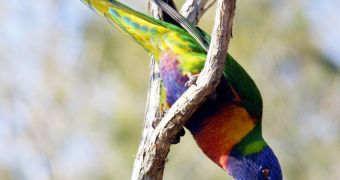
 14 DAY TRIAL //
14 DAY TRIAL // 
